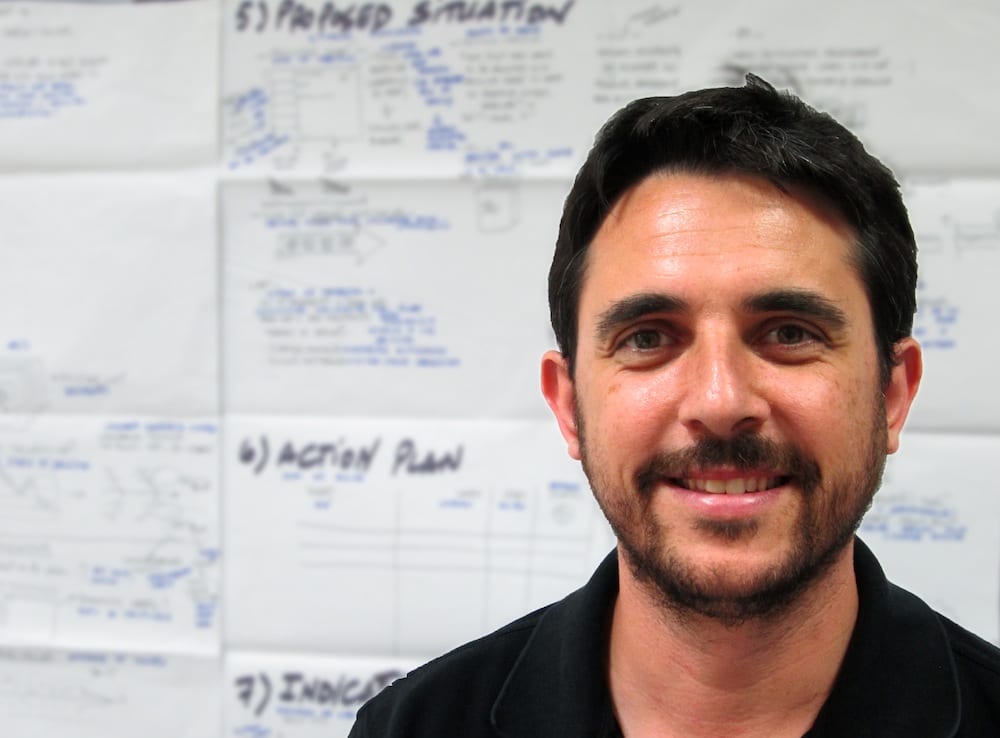With Kata, Simple Is the Key
Oct 5, 2022

FEATURE – A former plant manager reflects on his experience supporting a team with the implementation of Kata in the daily management system and explains why, when it comes to Kata questions, simple is best.
Words: Quim Prats, lean practitioner
When I became manager of a manufacturing plant in Catalonia, I inherited a rather difficult situation. The brand-new site (built to leverage new technology to improve our output in the production of sauce, one of the two lines of business) struggled to achieve the desired level of capacity utilization. The urgent need to increase output and efficiency put a lot of pressure on the team. Our people were young, dynamic, and enthusiastic, but we lacked structure, and our information flow was poor.
My previous experience at a large organization, where we were able to completely turn around a 35-year-old plant, had taught me the importance of “measuring to manage”. Without numbers and data, you can’t set and reach objectives, which is why the decision was made to introduce lean daily management, supported by the Kata methodology.
Our first step was running an introductory session, which was critical when it came to get people on board. On that occasion, the team heard about daily management for the first time and were inspired by what our coaches told them about its potential. Following the session, it was the team members themselves who enthusiastically drew the structure of the daily management meetings, with my support.
First, we decided what we wanted to measure and how. Then, we tried to create a kata “template” that, through simple questions, would help team participants to manage KPIs through the SQVCP structure (to ensure priorities are respected), track results, and take corrective actions whenever necessary. This stage in the process was simpler than I thought it would be. What was much more difficult was to be disciplined enough to maintain it and ensure people would show up at the 8 o’clock meeting day in and day out. For the first few months, I provided feedback following each meeting, until the people were able to drive it themselves.
Front-line people had never run meetings, and this approach made it very easy for them to do so. For leaders, it was great help, because it gave them a pattern to run the discussion. For operators, it was also very useful, because it helped them to focus their answers, thus making conversations more fruitful. Over time, coming prepared to the meetings became easier for them, because they already know what information they would be expected to present.
Once we started to measure, we could finally set clear standards and objectives, and constantly identify the gap between actual vs expected. Before kata, we had chaos. The approach set the rules of the game and gave us structure. Without it, we wouldn’t have achieved the results we achieved.
SIMPLE DOES IT
What I learned is that sometimes the simpler things give you better results than a complicated system. During that first meeting, when the team was first introduced to Kata, it occurred to me than we had never thought about the meeting in terms of questions. We only had a list of topics. The questions turned out to be incredibly powerful, in that they helped us to focus on what really mattered.
In safety, for example, our target was zero accidents. We had three kata questions related to that goal: “Were there any serious accidents in the past 24 hours?” “Were there any unsafe conditions detected in the past 24 hours? If so, were they reported?” and “Were there any unsafe behaviors detected in the past 24 hours?” When we found a problem (red), we took corrective action.
For quality, we had similar questions, related to internal non-conformities. “What is the result of the daily best practice audit?” and “Was the line interrupted for any reason?”
Critically, the questions didn’t just provide a script to reflect on what happened already; they also focused on what we expected to happen based on our planning. By doing so, they allowed us to set preventive actions that were meant to anticipate problems and that we would reflect on the following day (“Did it work?” and “What have we learned?”).
The surprise was that something as simple as these questions could give us such good results. We invested zero money, just a little bit of time to think through the questions (we went for easy ones that anyone could understand). Given the great results we achieved, this exercise was completely worth it.
Speaking of results, we had zero accidents resulting in sick leave for over two years. In quality, customer complaints went down by more than 60% in a year. On the same line, productivity doubled with the same number of FTEs, which meant that cost per kilo went down considerably. Furthermore, the kata-infused daily management system was critical is changing our culture and teaching us the importance of recognizing people’s achievement and virtuous behaviors.
SOME RECOMMENDATIONS
As a leader, when approaching the implementation of kata and daily management, you need to have a clear idea of what your macro-objectives are. These need to be broken down into smaller targets at front-line level: an operator needs to understand what their contribution is to overall business goals. Rather than talking about OEE, for example, ask people to report on how many times the line stopped or how many defective units were produced. In other words, ask yourself what OEE means to them.
Another recommendation is to never underestimate the importance of the follow-up: it’s critical to provide mentoring and guidance to the team, especially in the initial stages of the implementation.
Lastly, as mentioned earlier, I really think that when it comes to coming up with the questions, it’s best to focus on simple things. When we found simple, we found success.
Special thanks to the team who made this possible: Silvia (SNA), Marc (MNA), Guillem (GLU), Venus (VCO), Miquel (MAN), Paco (PCR), Gustavo (GRO), Roman (RFE), Xavi (XRO), Antonio (ALO). Their effort and discipline were key to the success of the project.
THE COACH COMMENTS
By Néstor Gavilán
 Quim inherited a brownfield. Even though his team was determined and full of energy, they needed to develop their lean capabilities. The language he spoke, thanks to his previous lean experience, had to be translated if he was to communicate effectively with both the front-line and top management. (It is sometimes difficult to explain to an operator how kata impacts their daily lives or to senior leader how organizing meetings around daily questions can impact results, but Quim did it.)
Quim inherited a brownfield. Even though his team was determined and full of energy, they needed to develop their lean capabilities. The language he spoke, thanks to his previous lean experience, had to be translated if he was to communicate effectively with both the front-line and top management. (It is sometimes difficult to explain to an operator how kata impacts their daily lives or to senior leader how organizing meetings around daily questions can impact results, but Quim did it.)
This may not be an example of “orthodox kata”, with cards carrying the questions and whatnot, but it is a great example of how the kata spirit can be injected into the daily management system, people development efforts, and even Leader Standard Work.
People who had never worked with daily management were able to do so, because a “script” was provided to them by means of the kata questions. Standardization made daily management very intuitive, especially thanks to the effort that was made to translate high-level objectives into practical targets for operators.
Another element that was true to the purest form of Kata was that the team not only came up with corrective actions to tackle problems that happened yesterday, but also began to look at what might happen tomorrow. This is the experimentation component of Kata, which encourages people to think proactively about ways to prevent problems from reoccurring and generates a culture of transparency in which problems are seeing as opportunities for learning.
THE AUTHOR

Quim Prats is a lean practitioner based in Catalonia.
Original Article: https://planet-lean.com/with-kata-simple-is-the-key/
Stay In Touch.
Subscribe to our newsletter and exclusive Leadership content.
We respect your privacy and won’t spam your inbox
